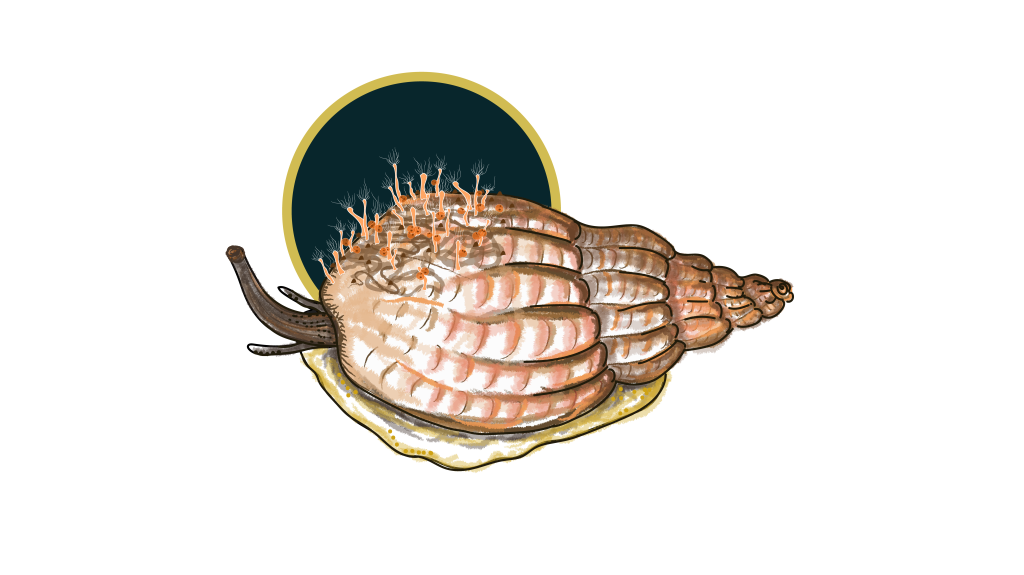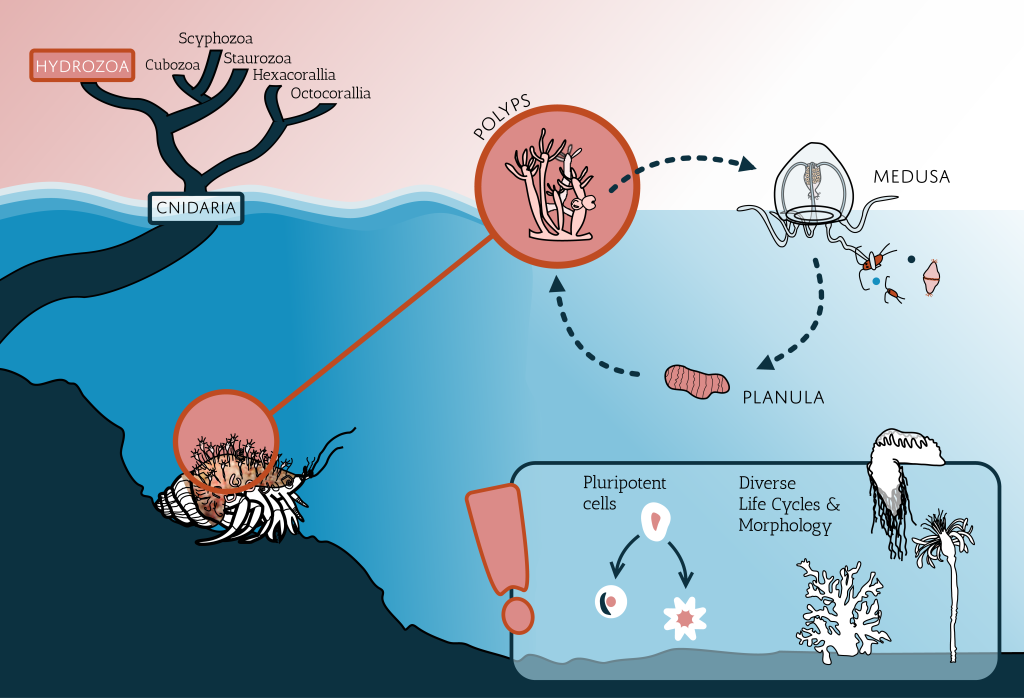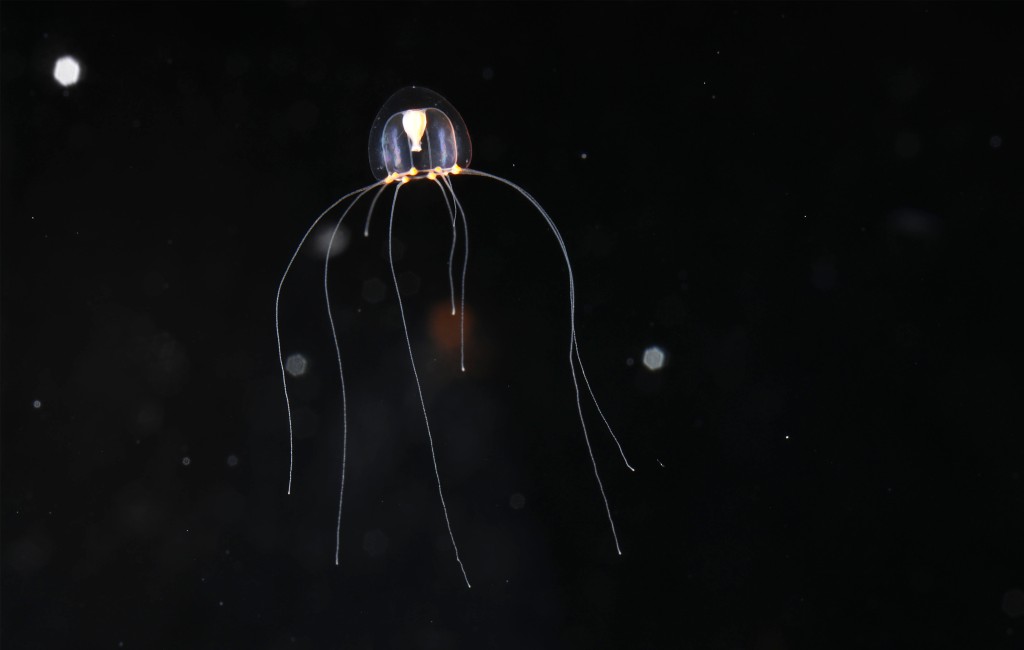From Tiny Polyps to the Origin of Stem Cell Research

Polyps of Schuchertinia allmanii. (Image Credit: Luis Martell, CC BY 4.0, Image cropped)
Earth is a fountain of incredible abundances and varieties of life-forms, with many of them still undiscovered. Biodiversity is a key pillar for our life as we know it, and we are not only a small fraction of it, but also use and harness this richness for the benefit of our own species’ advancement. Many human advances are based on other organisms’ attributes and talents, which is why we use certain species as “model organisms” when pioneering scientific breakthroughs. One example of such a specific form of life has helped us make some serious inroads into forms of regeneration and even immortality over the last few billion years ago, and leading us to great discoveries in science.
That form of life is the group Hydrozoa, a highly diverse group of Cnidarians. Cnidarians are the phylum comprising animals with stinging cells including corals, sea pens, anemones, ‘true jellyfish’ and much more. They cover a huge diversity of morphologies, ranging from small plant-like structures called polyps (e.g. some Tubularia), to wriggling medusa (e.g. Obelia) to colonies of free-swimming polyps (e.g. the famous Portuguese man o’ war Physalia physalia). The organisms belonging to this group possess a fascinating regeneration ability and some species are for example used for modern stem cell research.

That last point is why so much work has been done in hydrozoan model-species over the last few decades. Stem cells have the potential to differentiate in many different cell types that undertake special functions in the body. If a cell gets lost or damaged, stem cells can provide new cells that can transition to (almost) any specialized cell. The ability to regenerate itself and the potential for cell renewal make hydrozoans a great study object to understand stem cells and their role in development, diseases or aging. Additionally, the animals behind the research are pretty interesting and important in many respects!
[…] Both newcomers and trail-hardened biologists can for a moment enjoy […]. Watch such a [hydroid] colony, rooted to a sessile existence, give birth to a medusa which is irrevocably committed to a life in the plankton. Or be captivated by the apparently boundless energy of the swimming medusa and marvel that it is so tiny yet so perfect and that it is one of the most successful life forms to have evolved on this planet. As so often when nature is studied closely, a life-form that superficially seems simple in fact proves to be wondrously complex and, if one might be excused the phrase, beautifully designed.
Cornelius, P. (1995). Synopsis of the British Fauna. North-West European Thecate Hydroids and their Medusae. The Linnean Society of London.
Infinite Variety
One example of a hydrozoan species often used in research is the snail fur hydroid – Hydractinia echinata. The common name refers to their appearance and habitat because most colonies of this species live on top of snail shells and build a thick mat of polyps. Those shells are often inhabited by hermit crabs and the polyps feed on the left-overs from the crab’s meals and in return defend their host against predators. With their small tentacles, which are equipped with hundreds of cells containing venomous stingers (the nematocysts), they are great predators and catch tiny animals from the plankton.
Each individual polyp is connected to each other, building a colony of polyps with different functions. For example some polyps act as food suppliers (the gastrozooids), some as colony guards (the dactylozooids) and others as reproductive individuals (the gonozooids). In Hydractinia species the reproductive polyps grow small buds, which will release sperm or eggs (depending on the colonies’ sex) in the water. When egg and sperm meet they will fuse and develop into a small larva (called planula larva) which will swim for a while and settle down wherever the conditions are right. From then on it will grow to a polyp, which will create a new colony again.
The close relative Podocoryna carnea has a slightly more complicated but exciting life: instead of releasing eggs or sperm directly from the colony, their reproductive polyps grow tiny medusae (jellyfish), which will detach themselves when they are ready to swim. The medusa is morphologically comparable to the polyps, equipped with tentacles, a stomach, gonads and nematocysts – but living upside down and not attached to the sea floor. It can actively move through the water (or is dragged by currents) and will release eggs or sperm when it is mature, which will again follow the life cycle as described before. Those are only two examples of a great variety of life cycles and strategies in hydrozoans, which show a vast variety and many exceptions to the rules.

So to recap: the polyp colony releases genetic clones of itself in the water, which look and behave differently and are send into the ocean to reproduce. Some other hydromedusa species can even copy themselves and release medusa from the medusa itself. With those neat strategies, a single individual can produce loads of offspring and can disperse itself in the water. Even though they are tiny animals with polyps and medusae often just a few centimeters large, this massive productivity implies a large impact on the environment.
The Discovery of the Stem Cell
To look at the scientific discoveries in hydrozoans, we have to go back in time. Around 250 years ago the scientist Johan F. Blumenbach wandered around during his vacation and in a pond he found a green polyp – a specimen of the genus Hydra. This hydroid, the sessile stage, is a very simple member of Hydrozoa but not at all representative for this group, mainly because it lives in freshwater environments for a change and not the ocean. He took the small polyp with him and curious as he was, and as biologists like to do, cut it in two. A few days later, he observed that the bisected animal regenerated to a complete polyp again.
It took some years until biologists realized the importance of those experiments – probably conducted by many other scientists during that time. Ernst Haeckel was the first one who put the theory into words. In 1868 he coined the term ‘Stammzelle’, stem cell – cells that have the potency to self-renewal and which can develop into different cell types. He used this specific word ‘stem’ because he defined his finding as a tiny cell that underlies the huge stem of our Tree of Life.
Yet Haeckel did not discover the stem cell, rather the theory behind it. He also coined the expression through his famous manner of using metaphors. But Haeckel lacked the experimental back-up and the theory needed to be put into practice.
Luckily the evolutionary biologist August Weismann worked with hydrozoans, in fact with over 38 different species, including Hydractinia echinata. He conducted experiments on them and published his first findings in 1883 with a lot of subsequent work in following years. He was one of the first to connect heredity with embryology and framed the germ-plasm theory, where he distinguished between germ cells (e.g. egg or sperm cells) and somatic cells (body cells, e.g. muscle cells or neurons). His main point was that germ cells can transmit heritable information and that cells with properties of germ cells bring the potency for regeneration. Those cells are now called stem cells.
Weismann’s work was instrumental in the development of modern evolutionary biology in general. He emphasized the functions of germ cells and their heritable content and the difference between environmental effects and inheritance. Those basics laid the groundwork for genetics and developmental biology and his observations combined with that of many other scientists since form the basis stem cells biology we have today. Important findings of pluripotent stem cells, cells that can potentially develop into any kind of cell, the evolution of aging or origin of tumors are based on the work of Weismann and his colleagues and their work with hydrozoans (of course with other organisms too). Additionally, hydrozoans are further object for studies on the basic understanding of body plan development, toxin research and much more.

Great discoveries but yet overlooked
But despite the attention to a few species of Hydrozoa, their biology and ecological importance is generally overlooked, and there remains so much to learn about them. Lots of their diversity remains undiscovered in our oceans. In ecological studies and marine surveys they are generally overlooked because of their inconspicuousness and few characteristics traits. Since they are often part of diverse and productive marine forests, provide food and shelter for other animals, it is important to explore their diversity as well as to answer questions like: how do they live, how do they interact with other organisms and what is their ecological impact on ocean ecosystems? For that task and to fuel basic fundamental research we need taxonomists, ecologists and curious people fascinated by biodiversity and the small things in life.
Lara Beckmann is a master’s student at the University of Stockholm in the program ‘Biodiversity & Systematics’ and is currently working on her thesis project at the University Museum of Bergen focusing on the diversity of hydrozoans. You can read more about the hydrozoan diversity project NorHydro here, or follow Lara on Twitter here.
References and further reading
Dröscher, A. (2014). Images of cell trees, cell lines and cell fates: The legacy of Ernst Haeckel and August Weismann in stem cell research. (Springer) History and Philosophy of the Life Sciences 36, Vol. 2, 157-186
Frank, U., Plickert, G. & Müller, W. (2009). Cnidarian Interstitial Cells: The Dawn of Stem Cell Research. Rinkevich B., Matranga V. (eds) Stem Cells in Marine Organisms. (Springer, Dordrecht) https://doi.org/10.1007/978-90-481-2767-2_3
Haeckel, E. (1868). Natürliche Schöpfungsgeschichte. (Berlin: Georg Reimer)
Weismann, A. (1883). Die Entstehung der Sexualzellen bei den Hydromedusen. (Jena: Gustav Fischer)

Pingback: A Story About Mortality: What Jellyfish Can Teach Us | Ecology for the Masses
Pingback: A Story About Mortality: The Evolution of Aging and Death | Ecology for the Masses